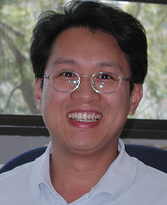Transform human skin cells into brain cells
Cancer-causing genes are generally considered mutant genes, which transform healthy cells into cancer cells. However, scientists at the Keck School of Medicine, University of Southern California (USC), USA, have demonstrated: Cancer-causing genes can also transform normal healthy cells into cells. Just like human embryonic stem cells. This finding led to the emergence of safer and more practical treatments, which treat diseases such as multiple sclerosis and cancer with stem cell therapy.
" In fact, this may be much more complicated, " said Jiang F. Zhong, MD, a pathologist at Keck School of Medicine. " What is a stem cell gene? What is a gene that causes cancer? It may be similar ."

Jiang F. Zhong and his colleagues converted human skin cells into brain cells.
Zhong and colleagues at Children's Hospital, in Orange County, California, United States and the Medical Center, Good Samaritan Hospital, in New York, USA, successfully converted human skin cells into brain cells. By inhibiting the expression of p53 protein, a protein encoded by a cancer-causing gene is being studied extensively . This suggests that the mutant p53 protein will help determine whether the cell's fate is good or bad, not just the result of cancer.
The results of the study are published online in the Proceedings of the National Academy of Sciences, July 18, 2011.
" When you turn off protein p53, we think that this cell will become a cancer cell, because we often focus on difficult situations ," Zhong said. " In fact, this cell will have more resins and can do better things. At this point, the cell is like a lost person (due to the p53 protein being turned off.) He can become a criminal. Or he can find other jobs that have a positive impact on society, because the social environment is very complex, so we will not know exactly the factors that influence and motivate him to do. follow this option or choose another option . "
Stem cells can divide and differentiate into different types of cells in the body. In humans, human embryonic stem cells (including: endoderm, mesoderm and epidermis) differentiate into germ layers, cells. The reason why and how stem cells are bound to specific tissues and organs is not clearly understood. However, human tissues and organs have grown from human embryonic stem cells. For example, endodermal leads to the formation of stomach, intestines and lungs; while the dermis leads to the formation of tissues, blood and heart. In his research, Zhong's team examined human skin cells, which are involved in the formation of brain and nerve cells from the epidermis.
When p53 protein has been inhibited, skin cells grow into the same cell wall as human embryonic stem cells . However, unlike other artificial stem cells (" multipurpose " and can become any other cell in the body,) these skin cells have been listed as stem cells: epidermis.
" IPSCs (aka versatile stem cells), can become anything, so it's difficult to control ," Zhong said. " The skin cells in our study are human embryonic stem cells in the epidermis ."
Zhong said: Repressing other cancer-causing genes in other cell layers, will also yield similar results, which has important implications for the treatment of stem cell therapy. Future research should focus on determining which genes to control.
The study was supported by the Children's Fund (CHOC), the Institute of Neuroscience (CHOC), the Austin Ford Foundation, the WM Keck Foundation, the National Institute of Medicine and the National Science Foundation.
- A breakthrough in transforming skin cells into brain cells
- Transform normal skin cells into brain cells
- Create tiny brain from human skin
- 10 interesting things about human skin
- Killing cancer cells with skin cells
- Transform skin cells into neurons
- Create brain cells from the skin
- Human brain stem cells
- Shocking facts about the human brain
- Making blood from human skin
- Turn skin cells into heart muscle cells
- Successfully cultivated mini human brains in the laboratory to try medicine
 Green tea cleans teeth better than mouthwash?
Green tea cleans teeth better than mouthwash? Death kiss: This is why you should not let anyone kiss your baby's lips
Death kiss: This is why you should not let anyone kiss your baby's lips What is salmonellosis?
What is salmonellosis? Caution should be exercised when using aloe vera through eating and drinking
Caution should be exercised when using aloe vera through eating and drinking